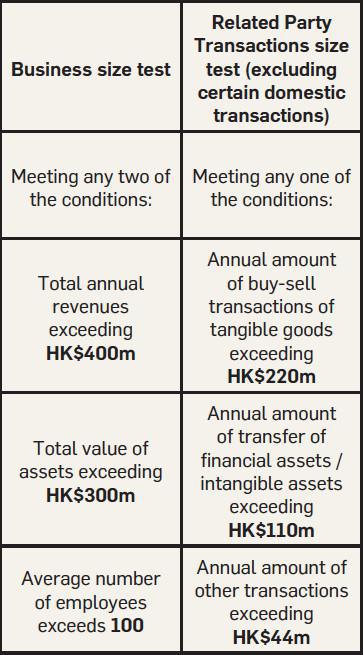Hong Kong’s new transfer pricing regime was enacted on 13 July 2018 through Inland Revenue (Amendment) (No. 6) Ordinance 2018. While most will instinctively first focus on the new transfer pricing documentation requirement, management of Hong Kong companies should take a broader and more strategic approach to managing their transfer pricing risks. They can do so by considering their whole-group risk profiles, not only in Hong Kong but also in other jurisdictions where their affiliated companies are in the same supply chain as the Hong Kong companies. As a general rule, minimizing transfer pricing risks in one jurisdiction means a corresponding elevation of transfer pricing risks in the counterparty’s jurisdiction. Balancing these risks and understanding the possible trade-offs are critical steps in managing the overall risks for the corporate group as a whole.
A change to transfer pricing may also require the management team of a company to recognize that, in addition to change in tax filing positions and the required documentation there may need to be meaningful changes in day-to-day operations, accounting treatment, funding structures, reallocation of human resources and/or reporting structures, and new legal agreements reflecting new structures. In some instances, regulatory bodies may need to approve these changes as well. A lot of people may therefore need to be involved in any change, which will take time to properly implement.
While transfer pricing legislation is new to Hong Kong, the reality is that most of its trading partner jurisdictions have already adopted their own transfer pricing laws and regulations and many have updated their regimes since the roll-out of the Organization for Economic Cooperation and Development’s (OECD) Base Erosion and Profit Shifting (BEPS) Action Plan Report in 2015.
This article discusses eight key elements of the regime for consideration by tax departments and company management.
Eight key elements of the regime
The arm’s length principle
The new regime strengthens the legal implementation of the arm’s length principle, previously introduced through the Inland Revenue Department’s (IRD) Departmental Interpretation & Practice Note (DIPN) No. 46 in 2009, as the fundamental transfer pricing rule in Hong Kong. This empowers the IRD to adjust profits or losses where a transaction price between two related parties departs from the perceived market price, leading to a tax advantage for the taxpayer in Hong Kong. However domestic related party transactions are exempted from the new rule if the transaction is: domestic in nature; does not give rise to an actual tax difference; and is not utilized for tax avoidance purposes.
Since the arm’s length principle came into force from the year of assessment 2018/19, irrespective of when a company’s documentation deadline may fall, transfer pricing arrangements that are inconsistent with the arm’s length principle will have to be corrected before that end of the fiscal period. It should also be noted that the arm’s length principle applies to all taxpayers even if they do not meet the threshold for preparing transfer pricing documentation (discussed below).
Transfer pricing documentation requirements
Through the consultation process before the finalization of the Bill, the government accepted views from the tax community that the thresholds for preparing transfer pricing documents proposed in the Bill were too low and adjusted the business and related party transaction size test thresholds upward. Hong Kong entities are required to prepare Master Files and Local Files for accounting periods beginning on or after 1 April 2018 if both tests below are met:
Groups whose annual consolidated revenues exceed HK$ 6.8 billion will also be required to file Country-by-Country Reports (CbCR) for accounting periods beginning on or after 1 January 2018.
While Hong Kong subsidiaries of large foreign multinational companies (MNCs) may rely on Master File created by their head office, the IRD requires Master Files to be produced in English or Chinese – which may not be the case – creating extra work for the group. Also, the relatively low Hong Kong threshold for Master File may mean medium-sized MNCs not meeting the Master File threshold in their home jurisdictions will need to produce a Master File for Hong Kong. As the content of the Master File sometimes contain strategic information of the group, it should be reviewed by all relevant stakeholders prior to its filing.
Penalties and non-compliance
The regime sets out penalties and creates offences. These include fines for non-compliance as well as criminal offences in cases of fraud. Generally, penalties for transfer pricing purposes are in the form of an administrative penalty amounting up to 100 percent of the tax undercharged criminal charges may be pressed for more serious non-compliance with CbCR obligations.
Treatment of intangibles
Section 15F allows for imposition of tax on Hong Kong taxpayers if they carried out value creation activities such as development, enhancement, maintenance, protection or exploitation (DEMPE) functions in Hong Kong that contributed to any intellectual property (IP) held by an overseas related party.
The recognition of the importance of DEMPE functions is a central thesis of the OECD BEPS Action Plan. In fact, most tax jurisdictions have adopted the principle and started refining how to enforce it. Some jurisdictions have gone even further and added additional requirements. For example, the Mainland’s State Administration of Taxation has added an extra “P” for value created by local promotion for marketing intangibles. This has created an environment in which most, if not all, tax authorities in different jurisdictions will seek to put a value to DEMPE contribution by people in its own jurisdiction against those elsewhere in the supply chain of the group.
Therefore, differences in opinions between authorities will likely lead to double taxation. Also, with the potential extensive information sharing under the new global transfer pricing regimes old practices may no longer be feasible. For example, it is common for local entities to choose to negotiate settlements with the local tax authorities on a one-off basis without affecting its affiliates’ position in other jurisdictions. Now, the group as a whole will need to have a clear, consistent view and articulation of where it thinks the value-added DEMPE functions are performed and how these functions attribute to the value of the intangible assets.
The current wording of Section 15F also creates a potential double taxation risk. Although, after concerns were raised by the tax community, the IRD reiterated that it will make sure that a person will not be subject to double tax in respect of the same income from any IP, Section 15F is silent on this matter. More details will be provided only in a forthcoming DIPN. To allow more lead time for taxpayers’ preparation, the rule’s effective date was deferred for 12 months and effective from 1 April 2019. Companies should therefore ensure compliance with the arm’s length principle and properly document details of value attribution models in relation to their IPs in both its Master File and Local File.
If modifications of operational structures are required in Hong Kong or other jurisdictions, Companies should also make sure that any changes satisfy local tax, regulatory, labour laws, accounting, funding and other reporting requirements. As the changes may involve internal – and sometimes external – stakeholders, implementing changes prior to the various deadlines may pose additional challenges.
Interests on loans
Despite introduction of the new transfer pricing rules in the tax legislation, the territorial source principle has not changed. Companies should review if interest is indeed chargeable, and if so, the company should also ensure that the interest rates and the relevant terms of related party loans comply with the arm’s length principle. For related party loans to foreign affiliates, taxpayers should be cautious about other requirements or limitations, such as thin capitalization rules in the other jurisdictions, to ensure compliance.
With respect to interest free loans between related entities in Hong Kong, emphasis will be on whether any tax advantage is created.
Attribution of profits to a permanent establishment
Specific provisions have been introduced which apply to any non-resident who has a permanent establishment (PE) that carries on a trade, profession or business in Hong Kong. The new transfer pricing regime effectively adopts the Authorized OECD Approach by treating the PE as a separate and distinct entity in determining attributable income or loss. The IRD has emphasized that this provision will not limit or alter the conditions for charging profits tax – meaning only those attributable profits that have a Hong Kong source will be subject to tax.
In view of the concerns of some stakeholders, particularly financial institutions, the application of this principle was deferred for 12 months and will apply for years of assessment beginning on or after 1 April 2019. The IRD will also provide further guidance on the application of this principle in a future DIPN.
Advance pricing arrangements
In addition to new compliance burdens, the new regime also brought some good news for taxpayers, through a formal advance pricing arrangement (APA) regime. With an established APA regime, it is expected that Hong Kong will be able to assist its taxpayers to enter into bilateral APAs with more tax jurisdictions. In addition, the IRD will also accept applications for unilateral APAs – which up to now have not been available.
The transfer pricing regime also provides for the rollback of transfer pricing methodology for APA purposes to prior years depending on the circumstances of each case. This provides taxpayers with an efficient platform to deal with complex transfer pricing issues over a longer period of time than before.
Dispute resolution mechanism
As jurisdictions, including Hong Kong, begin to increase enforcement of transfer pricing through new laws and regulations, it is expected that this will result in more disputes and double tax issues. To ensure effective resolution of these disputes, the regime provides for a statutory dispute resolution mechanism whereby (i) a taxpayer can present a case for a Mutual Agreement Procedure (MAP) and/or arbitration under a relevant tax treaty, and (ii) the IRD must give effect to any agreement reached with the other tax authority concerned in the course of the MAP or arbitration.
However, before these apply the regime also requires taxpayers to demonstrate that they have taken reasonable steps to limit the tax they have paid to the other tax authority before the IRD will consider double tax relief.
Also significant for some taxpayers is the deadline for applying for corresponding adjustments. These have been extended to the later of:
- The end of two years from the time when the foreign tax adjustment was made; or
- The expiry of the time limit for making an assessment / additional assessment under the Ordinance (i.e. six years).
In addition, the taxpayer is required to give written notice to the IRD within three months of the adjustment.
While having a statutory dispute resolution mechanism is indeed good news for Hong Kong taxpayers, there are very specific steps the taxpayers have to follow to be entitled to the relief. It is therefore very important for Hong Kong entities to be well coordinated with its related counterparts, to monitor the issues and progresses of each other’s transfer pricing audits and the appropriate competent authorities are notified and become involved at the appropriate moments.
The takeaway
Armed with its new enforcement tools and additional information that taxpayers will be required to provide, tax authorities, including the IRD in Hong Kong, will soon be asking more challenging questions that may lead to significant tax adjustments and potential double taxation.
It is therefore very important for Hong Kong corporate taxpayers to carefully revisit their transfer pricing policies, their positions with respect to their supply chains and related party uses of intangibles as well as the arm’s length nature of the provision of intercompany services, particularly services that may not have been compensated at arm’s length or at all in the past, and to ensure that these remain appropriate for their groups from Hong Kong and abroad, before deciding how to strategically comply with the new transfer pricing regime within the applicable deadlines.
Finally, companies should not simply focus on the documentation deadline. It is more important to be in compliance of the arm’s length principle on an ongoing basis and the deadline for making any meaningful changes before you are locked in is practically the end of your current fiscal year. Any changes in transfer pricing policies will likely require involvement of internal and or external stakeholders beyond tax and accounting departments and therefore even more lead time should be budgeted to ensure the necessary organization inputs are factored in.
Patrick Cheung is Transfer Pricing Services Partner at KPMG
















